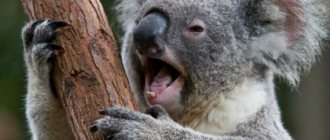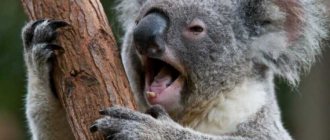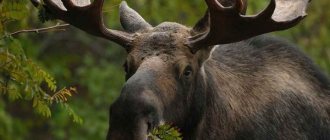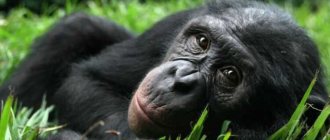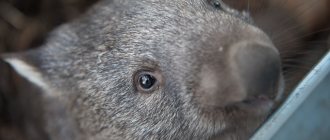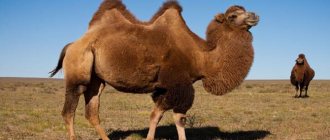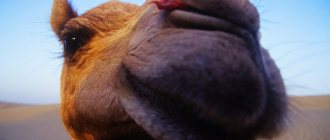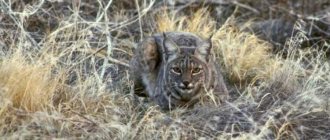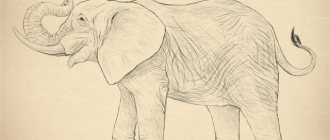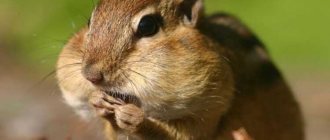The saiga, or saiga, is a cloven-hoofed mammal belonging to the antelopes, the only antelope living in Europe.
In the Pleistocene, the saiga lived throughout Eurasia from the British Isles in the west to Alaska in the east, but after global glaciation it survived only in the steppe zone of Eurasia.
Nowadays, saigas live in Kazakhstan, Uzbekistan, Kyrgyzstan, Turkmenistan, and Mongolia. In Russia, saigas are found in Kalmykia, the Astrakhan region, and the Altai Republic.
The male saiga is called saiga or margach, the female is called saiga.
Saigas inhabit exclusively open steppe landscapes, avoiding ravines and thickets of trees and bushes in every possible way. The saiga's favorite habitats are endless steppes with low grass and semi-deserts.
Today this species is endangered, is protected and is listed in the Red Book.
Appearance
The saiga is a relatively small animal. Belonging to the antelope subfamily, saigas have a small elongated body, no more than one and a half meters long, short legs and a small tail. The height at the withers does not exceed eighty centimeters, but is often less.
The weight of a saiga is usually from 25 to 60 kilograms, the weight of the animal depends both on the availability of food in the region and on the sex of the animal. Females are significantly smaller in weight and size than males.
Males have horns that are located vertically on the head and have a bizarre curled shape. They grow up to thirty centimeters in length.
The fur of the saiga in summer, with the exception of the belly, is sandy or reddish in color. On the belly, the saiga's fur is much lighter, sometimes even white. In the cold season, the saiga's fur becomes coffee-colored, in some places there are shades of gray or brown. In winter, the saiga's fur becomes much thicker and longer, which helps it cope with frost.
An interesting feature of the saiga is the unusual structure of its nose, which is more like a short trunk. The saiga's humped nose is very mobile and partially overlaps the lips in length. This unusual structure of the nose helps saigas survive safely in their habitats: in winter, cold air has time to warm up after inhalation; in summer, it is an additional filter that traps dust and prevents it from entering the body.
Habitats
In former times, the saiga's habitat was much larger, covering almost the entire territory of Eurasia, but after the global glaciation, the saiga survived only in the steppes and semi-deserts.
In Russia, saigas are found in the Astrakhan region, the Republic of Kalmykia, and Altai. On the territory of neighboring states, saigas live in Kazakhstan, Uzbekistan, Kyrgyzstan and Turkmenistan.
The natural habitats of saigas are steppes and semi-deserts, and they prefer to be on the plains rather than on hills, in mountainous areas or ravines.
This is due to the fact that it is quite difficult for them to navigate areas where they need to jump over any obstacles. Saigas prefer to amble, but they do not like to jump.
Saigas also do not like deep snow, so they prefer to spend the winter where there is no heavy snow cover.
Kalmyk antelope: who is it?
Saigas are the only wild ungulate mammals living in the steppe expanses of Russia. These amazing animals have been known since ancient times. They were contemporaries of long-extinct mammoths and saber-toothed tigers and occupied vast territories, inhabiting all of Eurasia right up to the coast of Alaska. Thanks to their excellent adaptability to any conditions and high fertility, antelopes have survived to this day. They did not suffer the fate of prehistoric mammoths and woolly rhinoceroses, but human activity has classified these animals as endangered species.
Lifestyle and habits
Saigas lead a nomadic lifestyle, and they gather in large herds, with a leader at the head of each herd. They go to the desert when snow begins to fall, and return to the steppe with the first warm days.
The animal can perfectly adapt to both drought and cold. In general, they quickly adapt to new conditions for themselves; they can live on poor nutrition and a small amount of water for quite a long time.
Herds of saigas move at a fairly high speed; weakened and sick individuals cannot maintain a high pace of movement, so they often lag behind and die from the teeth of predators.
When in danger, saigas easily pick up high speeds, which can reach 80 km/hour.
Saiga antelopes can swim; during migration, they can even cross a deep body of water or river without any difficulties.
Saigas live up to the age of nine years. Males live much shorter lives, usually no more than four.
What does the saiga eat?
Saigas are herbivores; their diet includes more than 100 different plants. Depending on their habitat and time of year, their diet varies greatly. In spring, saigas prefer to eat: licorice, kermek, fescue, wheatgrass, ephedra and wormwood. They satisfy their need for liquid by eating wildflowers: irises and tulips, which contain a significant amount of water.
In the summer, saltwort, quinoa and some other herbs are added to their diet. In summer, the grass in the steppe contains an insufficient amount of water for saigas, so they are forced to travel quite long distances in order to obtain the required amount of nutritious food and find reservoirs with drinkable water. Many plants that can be dangerous to humans are easily eaten by these animals without suffering from poisoning.
In winter, saigas often eat lichens and cereals. If strong winds come, then these artiodactyls can starve for quite a long time, hiding from bad weather, or switch to rougher food, for example, reed.
Saigas require from 3 to 6 kilograms of food per day, so saigas are forced to constantly move, and they even feed on the go.
Nutrition
A huge number of steppe plants are a favorite delicacy of saigas. They even eat greens that are poisonous and dangerous to pets.
In spring, steppe antelopes do not need to drink, because... the grass already contains all the necessary water. The largest percentage of liquid is found in wildflowers.
One individual eats about 4-5 kg of plants daily. In summer, when it gets hot, saigas migrate in search of water bodies.
Reproduction
The mating season begins in late autumn or early winter. During this period, the strongest males select several females, usually about five, and keep them in a small area of territory for further mating. A male can fight off more females if he has sufficient physical strength and sexual activity.
Rivals find each other by the smell of secretion, which is released from special glands of the animal located near the eyes. Males do not give up females without a fight, so fights often end in the death of the weaker opponent. Saigas eat little during this period, although they spend a lot of energy on courtship and fighting, so they become very exhausted and become easy prey for enemies.
Mating occurs later, already at the end of December. Saigas can mate already in the first year of life, but males only in the second. Gestation of the baby lasts five months. During pregnancy and childbirth, saigas leave the herd and settle in the steppes, away from water, in small groups. Thus, they try to protect their babies from dangerous animals that might notice them when they come to a watering hole.
Newborns weigh no more than three kilograms and are especially vulnerable during the first few days because they cannot walk. However, it is quite difficult to notice the motionless small body of a baby, so saigas calmly leave their cubs and go in search of food. Around the tenth day, they begin to walk and can move in the general flow, but the horns of small males begin to develop immediately after birth.
Security measures
Taking into account the plight that has arisen with the saiga population, the state has taken the necessary measures to protect the species in the areas of the Aral Sea, Kazakhstan and the Astrakhan steppes. Today, the Center, where wild animals of Kalmykia are studied, maintains a small, partly domesticated group as a reserve for the restoration of the species if unforeseen misfortunes occur with wild saigas. About 20 thousand saigas live in a limited space in Kalmykia on the territory of a created biosphere reserve. The Kalmyk antelope also lives in the Rostovsky Nature Reserve on Lake Manych-Gudilo.
The Wildlife Fund is helping to restore the saiga population - grants are allocated to maintain the established protection system for the margaca in Kalmykia.
Enemies in nature
Saigas are animals that prefer to get their food during the day, so they are very vulnerable at this time of day. The main enemy can be called the wolf, from which animals can only escape by flight. Having found a large herd that was not ready for an attack, wolves can destroy up to twenty-five percent of it.
However, such natural selection is sometimes even useful. Predators can only catch up with a weak or sick individual, this allows the herd to keep only physically strong and healthy representatives in its ranks. Dogs, foxes and other animals that can catch up with the herd also pose a danger.
The hardest thing is for the cubs; they do not yet have the strength and speed of an adult, and the saigas cannot always protect them, which is why they die more often. Not only wolves are dangerous for them, but also ferrets and even eagles.
Humans are also the enemy of saigas. By expanding their borders, people take away food from animals, thereby depriving them of the most valuable thing - food. Hunting and poaching also significantly reduce the population.
Life in captivity
Ecologists and specialists in the field of population expansion specifically resettled saigas in various zoos around the world in order to be able to preserve the gene pool for the further reproduction of these animals.
However, keeping them in closed and confined spaces was difficult. Due to their timidity and fear, the animals took off at high speed, trying to get away from danger and were often injured. This is how nature taught them to cope with their enemies and fears not through battle, but through flight. Many animals did not live to see a year, but scientists did not give up and, nevertheless, following certain rules, were able to visit saigas in captivity.
This required:
- mating was artificially postponed to a later date, so that saiga cubs would be born in a warmer period - at the beginning of summer, when it is much warmer;
- females and males lived separately;
- the diet has become more varied in order to increase the body’s resistance to various infections, both in children and adults.
However, these methods do not allow increasing the numbers of this species, but only provide a ghostly hope that saigas will not completely disappear. Life in captivity is difficult for them, but as long as there is a danger of losing these cute animals forever, they will be forced to stay in zoos.
Amazing animals that our grandchildren may not see
Due to the sharp decline in numbers, every possible effort must be made to preserve the species. Otherwise, our children and grandchildren will only be able to see a photo of the saiga animal. These beautiful animals deserve the right to life, so we need to stop exterminating their population for profit. If you have never seen the animal live, look at the photos of the saiga, they are so beautiful and unusual.
Saiga hunting and population decline
At the end of the last century, the saiga population began to decline significantly. The reason for this was poaching; people hunted for the horns of the animal, which were quite expensive and were used everywhere in medicine. The powder, which was made from the horns, could cure headaches, fever, and kidney and liver problems. It was often added to other medicines to enhance their properties. Animal meat was also valuable. The hunt for these artiodactyls became widespread.
At that time, they began to create special reserves, thereby trying to somehow improve the situation. However, this is not enough, because even today this species is on the verge of extinction. And this requires the use of not only special measures, but also the development of a specific strategy and large-scale program for the conservation of these unique animals.
Zoologists are calling for the opening of more and more nurseries and keeping saiga cubs in enclosures, which are not afraid of people. Choose a special, enriched diet for them, on which it will be easier for them to survive without mother’s milk. They are kept, presumably ten individuals in enclosures. These measures will not only allow young animals to adapt to herd life, but also partially restore the population of these unique animals.
Symbol of the modern Republic of Kalmykia
The life of the Kalmyk people has always been connected with the valuable species Saiga tatarica tatarica. Countless times they saved each other from hunger, cold, and other troubles. The endless steppes, the ever-running herd, which originated with mammoths, became a symbol of the country. Now, when, due to various circumstances, misfortune has come to the animals that survived the ice age, they are rescuing them in Kalmykia and Kazakhstan. The main reasons for the catastrophic decline in the number of saigas:
- Poaching. The low standard of living of the population makes it profitable to sell horns at 25 thousand/kg. The number of males is sharply reduced (there is 1 margach for every 35 females in protected reserves). In the hunt for saiga (the symbol of the steppes), high-speed modern equipment is used, which brings the animals to exhaustion and death without the use of firearms.
- Changes in habitats and migration routes due to climate change.
- Steppe fires, increased number of steppe wolves.
- Weakening of the system of protection, monitoring, population control, poor technical equipment of the teams monitoring the condition of saigas. Often herds migrate to territories without protection from poachers, which leads to the death of a large number of individuals.
The meat, skin, and horns of margach are always in demand by the population. The plans of specialists discuss the supply of gourmet meat to restaurants around the world to organize a profitable business. On the territory of endless steppes with unique flora and fauna, there are many natural monuments and attractions (the heritage of the Khazars, the cities of the Golden Horde, the Great Silk Road). Every year there is a thematic (environmental) festival dedicated to modern methods of preserving natural heritage. Among them, the saiga deservedly occupies a leading place. Since March 2015, saigas, the symbol of Kalmykia, have been included in the Red Book of the Republic of Kalmykia. Tourists who come to get acquainted with the nature of the country can try the national hunting dish shulum. It is prepared only in the steppe in a special pit. Finely chopped meat is placed in a bucket, brought to a boil, and cooked for 37 minutes. During cooking, add spices and vegetables (onions, garlic, peppers, pickled cucumbers, tomatoes). The finished meat is laid out separately and lightly salted. The broth is considered valuable. They drink it hot.
